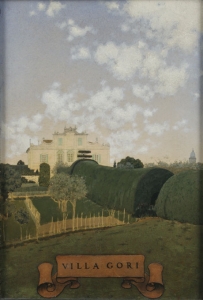
Maxfield Parrish (1870-1966)|La Palazzina (Villa Gori), Siena, 1903|Illustration for Italian Villas and Their Gardens by Edith Wharton (NY: The Century Co., 1904)|Oil on board|Society of Illustrators, Purchase Fund, 089.005
In 1902, Century magazine asked Edith Wharton (1862-1937) to write a series of articles about Italian villas and their gardens. To that end, Wharton visited some fifty villas traveling around Rome, Florence, Siena, Genoa, in Lombardy and the Veneto. Many were closed to the public. Maxfield Parrish was commissioned to create 26 color illustrations to accompany the articles; subsequently the publisher turned the work into a popular book that cost $6 in 1904. This was one of the first of Parrish’s illustrated books to be published in color.
Wharton’s book is organized by region. In the section on Sienese villas Parrish’s illustration is of the house and grounds of the estate of the De’ Gori family called La Palazzina. Also known as Villa Gori, it nestles in the hills overlooking Siena. The villa’s gardens were laid out in 1620. The most remarkable feature of this garden are the two allée of pleached ilexes leading away from the villa; one to the north west and the other (seen in the foreground) heading south west. Pleaching is the art of training trees into hedges through pruning and grafting; the ilex refers to the Holly Oak, also known as Oak, Holm, a perennial evergreen. Wharton describes Villa Gori’s tunnel hedge as “gnarled and interlocked trees, where a green twilight reigns in the hottest summer noon.” The foreground tunnel of the Parrish illustration ends in a thrush bird trap and the other extends to a “circular knoll or platform, surrounded by an impenetrable wall of square-clipped ilexes.”
As we can see in Parrish’s illustration, the hedge is segmented by paths cutting through the green. Just visible in the space between the green mass in the right foreground is a darker section indicating the interior tunnel. The pathways inside these green tunnels were sunk below the base of the trees and the inside greenery was clipped and neat as the outside, creating an airy cool interior walkway.
Typical in many of Parrish’s paintings of the Italian villa gardens is the compositional arrangement of a low horizon line and the inclusion of puffy cumulous clouds in the large area of pale blue sky. While later Parrish paintings are renowned for their skies of deep “Parrish blue,” the illustrations for Italian Villas and Their Gardens reflect the paler tone of the moisture and heat laden Mediterranean summer sky.
In a November 1904 New York Times review of Wharton and Parrish’s new book, the reviewer described the combination of efforts: “The book is made in a manner to show both author and illustrator to the fullest and best advantage.”* The reality is that Wharton had accepted the commission of Parrish for the illustrations under protest; she wanted garden plans to illustrate her text instead of pretty pictures. Parrish worked on his illustrations for Italian Villas in his studio in Cornish, New Hampshire using the sketches and photos he made during his own independent Italian jaunt. For this publication he arranged a new agreement with the publisher: while they would receive the reproduction rights for the images, Parrish would have the original art work returned to him for his future disposal.
* “Villas and Gardens of Italy” The New York Times (November 19, 1904)
February 4, 2010
By Joyce K. Schiller, Curator, Rockwell Center for American Visual Studies
Norman Rockwell Museum






